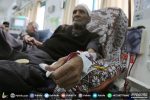I am struggling to understand the Israeli culture and mindset following the broadcast of the grainy video showing Hamas chief Yahya Sinwar’s final moments on this earth. The scene reminded me of the execution video of Iraq’s leader Saddam Hussein, moments before his demise.
The point of releasing such videos in a time of war, of course, is to humiliate your foe and diminish him in the eyes of others. In that sense, this particular video was a spectacular failure, and the tactic certainly backfired for the Americans when, on 30 December, 2006, Saddam was executed. For some bizarre reason, the US neocons thought that hanging Saddam would rally the entire Muslim world to their cause instead of reigniting the many and various resistance movements.
I was in Saudi Arabia at the time, having just performed the hajj pilgrimage, and it was the day of Eid Al-Adha across the Muslim world. Had the Americans just paused to reflect on the timing they would have realized that the decision to hang Saddam on one of the most important Islamic holidays — commemorating the willingness of Prophet Ibrahim (Abraham) to sacrifice his son Ismail as an act of obedience to God’s command — was not the day to send Saddam to meet his Maker.
However, US President George W. Bush, a man not known for displaying intellectual gravitas, failed to realise the significance of the date, as did his advisers. Believing their own propaganda, they also severely underestimated the prisoner who went to his death displaying an almost graceful calm, unlike his executioners who cowered behind their masks to conceal their identities.
The former Iraqi leader gazed with disdain at those around him as they yelled at him in a demonic fashion.
Saddam shouted back: “Allahu Akbar [God is the Greatest]. The Muslim Ummah will be victorious and Palestine is Arab!”
As the rope was placed clumsily around his neck, he was unmoved, and simply started to declare the Muslim testament of faith. “I bear witness that there is no god but God, and Muhammad…” The shameless executioners pulled the lever on the scaffold before he could complete the declaration with the words “…is the messenger of God.”
That day I was in the valley of Mina and went to speak to pilgrims from around the world. With the exception of some Iraqi Shia, no one celebrated or welcomed the news of Saddam’s execution. In fact, some pilgrims from Arab countries were distinctly uneasy. They were disgusted that Saddam had been executed on Eid Al-Adha.
READ: Hamas likely to name new leader from outside Gaza after Sinwar’s death
All of these memories came flooding back as I watched Thursday evening’s news about the killing of Yahya Sinwar. Unbelievably, we saw, through the lens of an Israeli drone, the final moments of the Hamas leader in a multi-story residential block near Rafah.
Sinwar, face covered by a keffiyeh, was sitting calmly on a dusty, well-upholstered armchair in what had obviously been someone’s family home in upscale Tal As-Sultan. No windows, most of the walls gone and exposed to the outside world, he sat almost motionless, camouflaged well in the dusty, bombed-out lounge.
He looked fearless and calm as he moved slowly to watch the drone. What most of us didn’t notice was that his left arm was reaching for a long piece of wood as the drone hovered ever closer to him.
“Whatever people think of Sinwar, he died the death of a Hollywood hero,” wrote one observer on social media. “The last man standing, alone amongst his dead comrades, covered with dust, barely alive, against overwhelming odds, using his one remaining arm to throw the closest weapon he could reach [the piece of wood] towards the mindless drone operated by a coward hiding behind the machine. It’s like ‘Terminator’ but real. And the Israelis think they humiliate Sinwar and Palestinian resistance by making this public. There’s something deeply wrong with Israeli society.”
I couldn’t agree more.
The Israelis would no doubt have wanted to find Sinwar cowering in a corner in the tunnel network in which the occupation army claimed he was hiding as their manhunt began. As it turned out, the drone operator had no idea that he was looking at Israel’s most wanted man. Moments later a tank shell was fired into the building.
In a televised address, a gloating Israeli Prime Minister Benjamin Netanyahu said that Sinwar — the architect of the deadly cross-border incursion against the Zionists who occupy his country and oppress his fellow Palestinians — “ran away in fear from our soldiers” prior to being assassinated. “He told you he was a lion, but in reality, he was hiding in a dark den — and he was killed when he fled in a panic from our soldiers,” claimed Netanyahu on Thursday as he hailed Sinwar’s killing.
Was anyone convinced by Netanyahu’s words after watching the drone footage? I doubt it. Yet more lies from that most accomplished of liars and hopefully soon to be arrested war criminal. Sinwar certainly wasn’t running when the drone spotted him. Nor did he look scared as he sat, defiant, in full view of his killers.
Compare that video with the image shared on social media of Netanyahu’s obnoxious son Yair idling in the luxury $5,000 a month Hallandale Beach complex since January in the American sunshine state of Florida. A cowardly draft dodger avoiding service in a cowardly, immoral army.
If anything, the Israeli video of that bombed out apartment just north of Rafah city could prove to be the best recruitment tool for the military wing of Hamas, because it shows why Palestinians called Sinwar their “lion”. Once again, the so-called TikTok army appears to have shot itself in the foot.
I’m told that there were strong rumors that far from hunkering down in Gaza’s tunnels, Sinwar chose to fight alongside the youngest members of the Izzedine Al-Qassam Brigades on the front lines after the political murder of Ismail Haniyeh, the much-loved Palestinian politician who was the political leader of Hamas.
Sinwar told his comrades who urged him to be more cautious, “I just want everyone from the resistance to understand that my life is not more important than anyone in the front line, and real leaders fight in the front, and if I go, we have already selected the successor.”
It is well documented among his inner circle that Sinwar didn’t regard his life as being more important “than the lives of the children who die.”
As the genocide continues it is still too early to say what Sinwar’s legacy will be, but I suspect his actions in this life will loom far larger and much longer as a lion in the Palestinian history books.
When I visited the brigades during my last trip to Gaza, I was told that around 85 per cent of the young freedom fighters in Hamas were orphans and were already highly motivated and primed for battle. Having the elusive Sinwar in their front-line positions alongside them must have been a huge inspiration.
It matters not what weasel words come from Tel Aviv, Washington, London or anywhere else, Sinwar proved that he was fearless and fought to the very end, hurling a broken piece of wood at his tormentor when he barely had the strength to move. Most Western leaders are complicit in Israel’s genocide, and utterly shameless.
Yahya Sinwar knew that death was inevitable, but when it came he embraced it on his own terms. He died as another Palestinian hero, and we have the evidence thanks to an Israeli drone operator who only stumbled on him by accident.
-British journalist and author Yvonne Ridley provides political analysis on affairs related to the Middle East, Asia and the Global War on Terror. Her work has appeared in numerous publications around the world from East to West from titles as diverse as The Washington Post to the Tehran Times and the Tripoli Post earning recognition and awards in the USA and UK. Ten years working for major titles on Fleet Street she expanded her brief into the electronic and broadcast media producing a number of documentary films on Palestinian and other international issues from Guantanamo to Libya and the Arab Spring. Her article appeared in MEMO.











